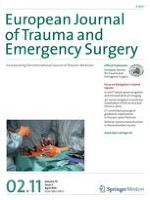Erschienen in:

01.04.2011 | Original Article
Fournier’s gangrene: analysis of prognostic variables in 34 patients
verfasst von:
A. García Marín, J. Martín Gil, A. Vaquero Rodríguez, T. Sánchez Rodríguez, J. de Tomás Palacios, J. Lago Oliver, F. Turégano Fuentes
Erschienen in:
European Journal of Trauma and Emergency Surgery
|
Ausgabe 2/2011
Einloggen, um Zugang zu erhalten
Abstract
Introduction
Fournier’s gangrene (FG) is the necrotizing fasciitis of the perineum and genital area. The objective of this study was to assess risk factors for mortality.
Materials and methods
We conducted an analytic and retrospective study of the patients with FG treated at our institution between 1998 and 2008. Statistical analysis was performed with the Statistical Package for Social Science for Windows, version 15.0, using the Mann–Whitney test for quantitative variables, and the chi-square and Fisher exact tests for qualitative variables, in univariate analyses.
Results
Of the 34 patients treated, 25 survived (74%) and 9 died (26%) with a median timing of 29 days (13, 60). Statistically significant differences were not found in age, sex and predisposing factors, except heart disease (p = 0.034). Admission laboratory parameters and severity criteria showed significant differences in serum urea (p = 0.007), potassium (p = 0.008), alkaline phosphatase (p = 0.014) and Fournier’s gangrene severity index score (FGSIS) (p = 0.008). Others factors such as duration of symptoms before hospital admission, extent of body surface area, number of surgical debridements, additional surgical manoeuvers (supra-pubic catheterization or colostomy), microbiological cultures and ICU stay did not show significant differences.
Conclusions
FG is a life-threatening necrotizing fasciitis with a high mortality rate. In our study, prognostic variables were heart disease, admission serum urea, potassium, alkaline phosphatase, and FGSIS. More studies are needed to validate these findings.